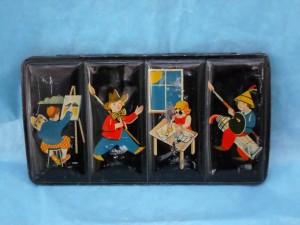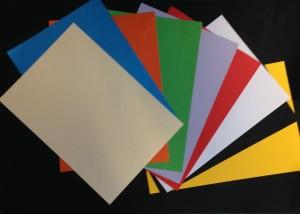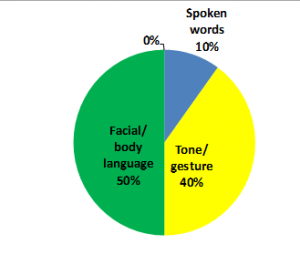Ideas on preaching from the Christian Resources Exhibition
Last month I gave a seminar at the Christian Resources exhibition on the ‘Preacher’s paint box’. The idea was drawn from my childhood, as I have vivid memories of opening the lid of a new paintbox and feeling a frisson of excitement at all the possibilities it contained. What if preacher’s could feel a similar tingle of creative possibility at the prospect of crafting a new sermon from the words and skills at their disposal?

A 1930s gem…
Since my aim was to speak about the power of words, like the great Alistair Cooke saying that he ‘preferred television to radio, as the pictures were better’, this seemed like an occasion to ditch the power-point and go with something simpler. My presentation was supported by the 9 sheets of coloured card you see below.

9 colours
Flesh tones
It is important that the preacher remembers to look after him or herself as a real flesh and blood human being. We may do this by something as simple as taking a nap on a Sunday afternoon, or by choosing to work in a different environment when we write a sermon so as not to stagnate. Feeding the mind matters too. In doing so it is important that creative communicators expose themselves to the creative communication of others – in novels, films, plays or works of art.
Blue
My eyes happen to be blue, but you won’t be able to tell that when I preach if I am forever avoiding eye contact with you. As human beings we read truth and falsehood, sincerity and engagement from the eyes. A little more on that here from the Preacher’s A to Z:
When you first begin to preach, you may find the whole business of eye contact very disconcerting. You may feel that people are staring at the spot of breakfast you failed to wash off your cheek, or seeking to communicate some unspoken approval or disapproval to you. Resist the temptation to lose your concentration by interpreting every facial gesture you observe. After all, you might be quite wrong! Avoid, too, the ‘nodding dog’ approach – where you simply sweep your gaze from one side of the congregation to the other like one of those toy dogs on the parcel shelf of a car. When you first start you may find it helpful to pick a spot in the air just above the back row and focus on it. With time, though, you will relax into a more natural form of eye contact with your congregation. You may even learn to enjoy this collection of faces.
Orange
Having driven many time sin France, I know of their great love for flashing orange road signs – the purpose of which is not always obvious! The most spectacular one I ever saw was a full size animated mannequin, dressed in day-glo vest, who was waving flags up and down to warn of road works. It was a gesture you could not miss! Note how much we “read” from gesture:

Green
As a (very average) watercolour painter, I know that green can be the hardest tone to get right in landscape painting. Too much blue in the mix and it feels cold, too much yellow and it feels acidic. Radio work has taught me the value of tone and that a good tone can enhance and average script, whereas a poor tone can ruin even the very best script. We cannot help but read the tone of the preacher – which means that he or she must select it carefully.
Purple
It was the ancient writer Horace who declared that ‘purple passages’ were unnecessary in prose to make it interesting. That said, most preaching is so anodyne that it could do with a splash more color. Too often it addresses only the analytical left side of the brain and not the creative right side. Preaching must cross over the brain’s divide to forge neural pathways, or synapses, where the lesson preached can be retained. Consider the great Exilic prophets, whose prophecies contained no new theology, but evoked old truths with such startling poetry as to make it seem new.
Red
Red is, of course, the color of passion. We need passionate preachers – like the great S.M Lockridge of old. However, there is a narrow dividing line between passion and anger in human speech. It is worth considering that an intentionally quiet voice may convey great passion, and that silence in speech functions like white space on a page – making us notice the words all the more.
White
When painting, the pure color white must be used with extreme caution, as it draws the eye instantly. Even a speck of it can affect the whole painting. However, when dealing with big themes the small highlight can be a way to highlight the issue. Consider this excerpt from Stale Bread, in sermon on John 5 1 – 11 entitled ‘the death of expectation':
38 years is a long time. Younger men had come since then, men with families and friends to carry them when the moment came. By now, even his view of the water was obscured. Way back, underneath the colonnade, his day was spent looking at the twisted backs and passing healthy feet of others.As expectation died, and hopes withered – tiny things became absorbing. Today he was watching a beetle in the dust by his wretched feet. For hours on end it had been struggling to roll a morsel of bread away from the crowd – to feed its children, perhaps. The morsel was two or three times its size, and many times it had rolled back on top of the hapless creature – mocking its efforts. ‘Give up’, the man mouthed – ‘its easier in the end.’ But the creature would not give up, and was rallying from its last defeat, when the man’s view was obscured.
Black
When used carefully in a painting, black can bring real depth – turning an object three-dimensional through shadow, or making a doorway so intriguing you want to walk through it. There are times when every preacher will have to preach in the midst of personal sorrow. They should not parade it for all to see, buy equally they should not eschew the depth it may bring to preaching. In his book, the Jazz of Preaching, Kirk Byron Jones talks about this:
‘When it comes to preaching through times of emotional strain and pain, the question is not how to preach when your heart is not in it. The question is how to preach with a different heart, a wounded heart.
Yellow
When all is said and done, preaching is a great privilege, and should put a little sunshine in our hearts. It puts us in a line of prophetic speech stretching all the way back to Isaiah – as Paul expresses in Romans 10 v.15. The preacher;s words, so carefully crafted, may have an impact months or years after they are preached.
Why not enjoy these 40 seconds of color as you contemplete your paintbox today?
